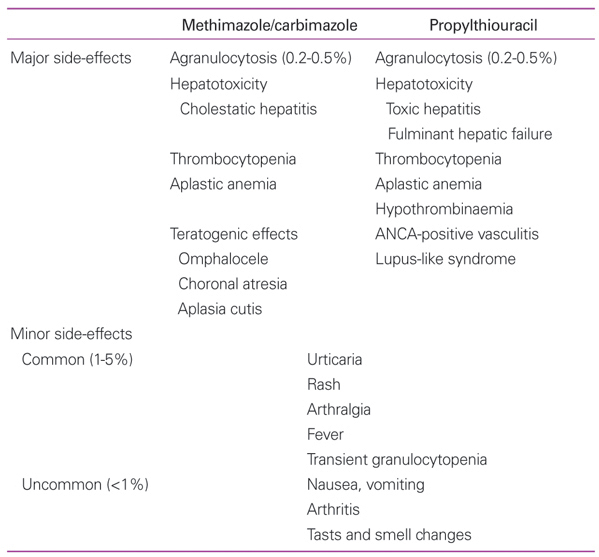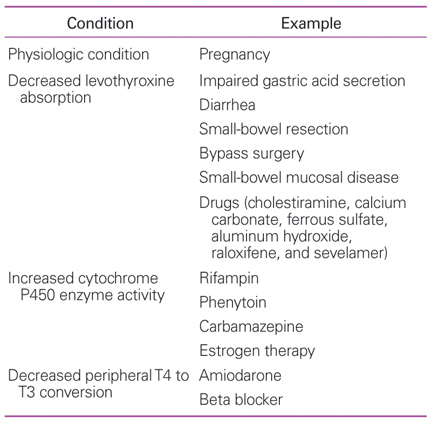 |
 |
- Search
| J Korean Med Assoc > Volume 55(12); 2012 > Article |
Abstract
Thyroid disorder is a common disease. Graves' disease is the most frequent cause of thyrotoxicosis and pharmacological treatment is current trends worldwide. Because of the severe adverse effects of propylthiouracil, methimazole or carbimazole should be selected as the drug of choice except for special situations such as women in the first trimester of pregnancy, thyroid storm, or in patients with severe side effects to methimazole. Treatment should continue for 12 to 18 months, but duration can be adjusted depending on the patient. For hypothyroidism, synthetic levothyroxine is the mainstay of treatment. In order to avoid overtreatment, the dosage of levothyroxine should be determined in consideration of the patient's age, sex, bodyweight, general condition, and comorbidities. In subclinical hypothyroidism, thyroid hormone replacement is suggested in patients with thyroid stimulating hormone concentrations >10 mIU/L. For non-elderly patients with high titers of thyroid autoantibodies, patients with dyslipidemia, pregnant patients, and women with infertility or ovulatory dysfunction, treatment with levothyroxine can be considered.
References
1. Emiliano AB, Governale L, Parks M, Cooper DS. Shifts in propylthiouracil and methimazole prescribing practices: antithyroid drug use in the United States from 1991 to 2008. J Clin Endocrinol Metab 2010;95:2227-2233.
2. Bahn Chair RS, Burch HB, Cooper DS, Garber JR, Greenlee MC, Klein I, Laurberg P, McDougall IR, Montori VM, Rivkees SA, Ross DS, Sosa JA, Stan MN. American Thyroid Association. American Association of Clinical Endocrinologists. Hyperthyroidism and other causes of thyrotoxicosis: management guidelines of the American Thyroid Association and American Association of Clinical Endocrinologists. Thyroid 2011;21:593-646.
3. Abraham P, Avenell A, Park CM, Watson WA, Bevan JS. A systematic review of drug therapy for Graves' hyperthyroidism. Eur J Endocrinol 2005;153:489-498.
4. Razvi S, Vaidya B, Perros P, Pearce SH. What is the evidence behind the evidence-base? The premature death of block-replace antithyroid drug regimens for Graves' disease Eur J Endocrinol 2006;154:783-786.
5. Laurberg P, Berman DC, Andersen S, Bulow Pedersen I. Sustained control of Graves' hyperthyroidism during long-term low-dose antithyroid drug therapy of patients with severe Graves' orbitopathy. Thyroid 2011;21:951-956.
6. Konishi T, Okamoto Y, Ueda M, Fukuda Y, Harusato I, Tsukamoto Y, Hamada N. Drug discontinuation after treatment with minimum maintenance dose of an antithyroid drug in Graves' disease: a retrospective study on effects of treatment duration with minimum maintenance dose on lasting remission. Endocr J 2011;58:95-100.
7. Klein I, Becker DV, Levey GS. Treatment of hyperthyroid disease. Ann Intern Med 1994;121:281-288.
8. Mazza E, Carlini M, Flecchia D, Blatto A, Zuccarini O, Gamba S, Beninati S, Messina M. Long-term follow-up of patients with hyperthyroidism due to Graves' disease treated with methimazole. Comparison of usual treatment schedule with drug discontinuation vs continuous treatment with low methimazole doses: a retrospective study. J Endocrinol Invest 2008;31:866-872.
9. Allahabadia A, Daykin J, Holder RL, Sheppard MC, Gough SC, Franklyn JA. Age and gender predict the outcome of treatment for Graves' hyperthyroidism. J Clin Endocrinol Metab 2000;85:1038-1042.
10. Rivkees SA, Mattison DR. Ending propylthiouracil-induced liver failure in children. N Engl J Med 2009;360:1574-1575.
11. Noh JY, Yasuda S, Sato S, Matsumoto M, Kunii Y, Noguchi Y, Mukasa K, Ito K, Ito K, Sugiyama O, Kobayashi H, Nihojima S, Okazaki M, Yokoyama S. Clinical characteristics of myeloperoxidase antineutrophil cytoplasmic antibody-associated vasculitis caused by antithyroid drugs. J Clin Endocrinol Metab 2009;94:2806-2811.
12. Eom YS, Choi B, Lee S. A case of ANCA-associated vasculitis after propylthiouracil re-treatment. J Korean Thyroid Assoc 2011;4:135-137.
13. Clementi M, Di Gianantonio E, Cassina M, Leoncini E, Botto LD, Mastroiacovo P. SAFE-Med Study Group. Treatment of hyperthyroidism in pregnancy and birth defects. J Clin Endocrinol Metab 2010;95:E337-E341.
14. Bach-Huynh TG, Nayak B, Loh J, Soldin S, Jonklaas J. Timing of levothyroxine administration affects serum thyrotropin concentration. J Clin Endocrinol Metab 2009;94:3905-3912.
15. Vanderpump M. Pharmacotherapy: hypothyroidism-should levothyroxine be taken at bedtime? Nat Rev Endocrinol 2011;7:195-196.
16. Boeving A, Paz-Filho G, Radominski RB, Graf H, Amaral de Carvalho G. Low-normal or high-normal thyrotropin target levels during treatment of hypothyroidism: a prospective, comparative study. Thyroid 2011;21:355-360.
17. Chung HW, Kang BM, Kim MR, Yoon BK, Lee BS, Choi H, Park HM, Kim JG. The influence of thyroid function on bone mineral density in Korean postmenopausal women. J Korean Soc Menopause 2012;18:36-42.
18. Kim MH, Kang MI. Long-term effect of prolonged TSH suppression on the skeletal system. J Korean Thyroid Assoc 2012;5:31-38.
19. Park HW, Park DG, Park CM, Kim SE, Lee JH, Han KR, Oh DJ. Reversible right heart failure and variant angina associated with hyperthyroidism. Korean J Med 2009;76:584-588.
20. Devdhar M, Drooger R, Pehlivanova M, Singh G, Jonklaas J. Levothyroxine replacement doses are affected by gender and weight, but not age. Thyroid 2011;21:821-827.
21. Wekking EM, Appelhof BC, Fliers E, Schene AH, Huyser J, Tijssen JG, Wiersinga WM. Cognitive functioning and well-being in euthyroid patients on thyroxine replacement therapy for primary hypothyroidism. Eur J Endocrinol 2005;153:747-753.
22. Grozinsky-Glasberg S, Fraser A, Nahshoni E, Weizman A, Leibovici L. Thyroxine-triiodothyronine combination therapy versus thyroxine monotherapy for clinical hypothyroidism: meta-analysis of randomized controlled trials. J Clin Endocrinol Metab 2006;91:2592-2599.
23. Panicker V, Saravanan P, Vaidya B, Evans J, Hattersley AT, Frayling TM, Dayan CM. Common variation in the DIO2 gene predicts baseline psychological well-being and response to combination thyroxine plus triiodothyronine therapy in hypothyroid patients. J Clin Endocrinol Metab 2009;94:1623-1629.
24. Biondi B, Cooper DS. The clinical significance of subclinical thyroid dysfunction. Endocr Rev 2008;29:76-131.
25. Gharib H, Tuttle RM, Baskin HJ, Fish LH, Singer PA, McDermott MT. Subclinical thyroid dysfunction: a joint statement on management from the American Association of Clinical Endocrinologists, the American Thyroid Association, and the Endocrine Society. J Clin Endocrinol Metab 2005;90:581-585.
26. Somwaru LL, Arnold AM, Joshi N, Fried LP, Cappola AR. High frequency of and factors associated with thyroid hormone over-replacement and under-replacement in men and women aged 65 and over. J Clin Endocrinol Metab 2009;94:1342-1345.
27. Lee YK, Kim JE, Oh HJ, Park KS, Kim SK, Park SW, Kim MJ, Cho YW. Serum TSH level in healthy Koreans and the Association of TSH with serum lipid concentration and metabolic syndrome. Korean J Intern Med 2011;26:432-439.
28. Razvi S, Weaver JU, Vanderpump MP, Pearce SH. The incidence of ischemic heart disease and mortality in people with subclinical hypothyroidism: reanalysis of the Whickham Survey cohort. J Clin Endocrinol Metab 2010;95:1734-1740.
29. Rodondi N, Bauer DC, Cappola AR, Cornuz J, Robbins J, Fried LP, Ladenson PW, Vittinghoff E, Gottdiener JS, Newman AB. Subclinical thyroid dysfunction, cardiac function, and the risk of heart failure. The Cardiovascular Health study. J Am Coll Cardiol 2008;52:1152-1159.
30. Lee YW, Kim DS, Kim TY, Lee CB, Park YS, Choi WH, Kim TW, Kim TY, Jun JB, Bae SC, You DH, Kim SY. Thyroid autoantibodies and thyroid dysfunction in rheumatoid arthritis. Korean J Med 2000;58:317-323.
31. Lee EJ, Jeon HS, Eo SH, Ha TS. A case of goodpasture's syndrome in a patient with graves' disease. Korean J Nephrol 2006;25:121-126.
- TOOLS
-
METRICS

-
Related articles in
J Korean Med Assoc -
Clinical features and treatment of rosacea2024 May;67(5)
Medical treatment of pediatric obesity2024 May;67(5)
Intratympanic injection for treatment of inner ear diseases2023 October;66(10)
Pharmacological treatment of Ménière disease2023 October;66(10)
Recent advances in the treatment of multiple myeloma2023 April;66(4)







